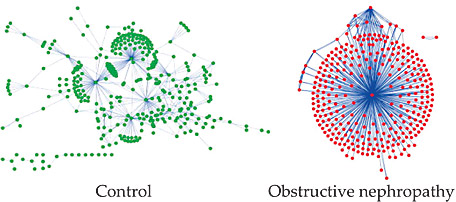Network analysis diagnoses kidney disease
DOI: 10.1063/PT.3.1286
Network analysis diagnoses kidney disease. Obstructive nephropathy (ON) is the most common kidney disease among children. Sufferers have a blockage of the urinary tract, which forces urine back into the kidney. If unrecognized and unchecked, the ensuing damage shuts down the organ. In principle, kidney function and malfunction are reflected in the metabolites that pass through the kidney and the regulators that control the metabolites’ consumption and production. But of the myriad species of metabolites and regulators, which ones presage ON? To answer that question, Massimiliano Zanin and Stefano Boccaletti of the Technical University of Madrid turned to network theory. Their starting point was a database of 852 metabolites and 834 regulators (microRNAs) drawn from 10 ON patients and a 10-member control group. Levels of metabolites and regulators varied within each group. Still, it proved possible to construct for each metabolite (or regulator) a network that embodied how far every other metabolite (or regulator) deviated from its statistically expected correlation. As the examples in the figure show, control group networks had amorphous topologies, whereas ON networks had star-like topologies centered on the most abnormal metabolite or regulator. Thanks to their simplicity, ON networks are more “efficient” than control networks—that is, the paths between all their node pairs are shorter on average. That difference, Zanin and Boccaletti propose, could underlie an early ON diagnostic. (M. Zanin, S. Boccaletti, Chaos 21, 033103, 2011 doi: http://dx.doi.org/10.1063/1.3608126






